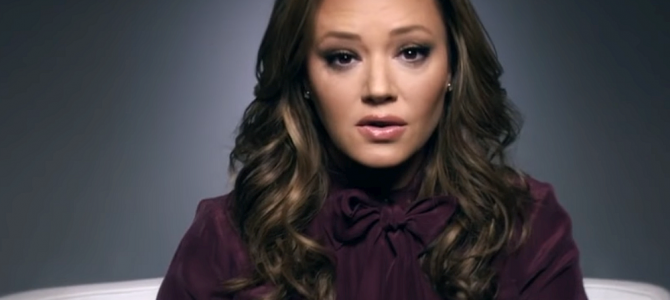
The second installment of Leah Remini’s series on Scientology, “Scientology: the Aftermath,” has produced more bad news for the cult: adding Remini’s celebrity to the project is garnering record numbers of viewers, with 2.7 million people tuning in to watch the story of Mike Rinder, the former international spokesman for Scientology, and one of its most effective opponents.
In the anti-Scientology world, the most well-known figures are either journalists like Tony Ortega or high-profile defectors, like Rinder. The third episode of Remini’s series focused on figures most casual Scientology watchers are unfamiliar: average former practitioners who have quietly escaped, but not without losing shocking amounts of money, not to mention close family members. Remini and Rinder traveled to learn what life was like for Mary Kahn in her 40 years in the “church” and what it has been like since her defection in 2013.
Scientology’s Positive Energy Drew Khan In
Surprisingly and importantly, Kahn spends some time discussing the positive aspects of her involvement, which is what initially drew her into being involved in the early 1970s. She told Remini, “It was great, it helped me so much. I hit this vein of people who didn’t want to do drugs. It was about working hard and living a good life. These are good principles.”
While many on the outside of Scientology view it as a sci-fi cult, Kahn artfully explained how and why it is able to draw in adherents. Its followers aren’t a bunch of mindless lemmings, and treating them as such does a disservice to efforts at freeing them from its grasp when it begins to tighten, as it inevitably does.
Soon, Kahn was moving up the “Bridge to Total Freedom”—the Scientology blueprint for spiritual enlightenment. In the beginning of the third episode, Remini and Rinder discuss how far they both traveled up the Bridge, and how much money it costs to do so. Traveling up the Bridge promises practitioners the ability to move objects with their mind, obtain optimal communication skills, and even cure themselves of physical ailments.
The cost to Remini, a Hollywood celebrity, was in the millions, but even for an upper-middle-class family like the Kahns, Kahn estimates she spent hundreds of thousands of dollars just in her last decade of involvement with Scientology under the control of David Miscavige. Miscavige’s focus since taking control of the “church” has been monetary enrichment, and Kahn’s disaffection with the organization amplified greatly with the financial pressure on her family.
Afraid of the “church’s” power and its ability to force its members to disconnect from family who have left, Kahn kept secret the doubts she was experiencing. While she eventually was able to leave and remain married, her greatest loss in a post-Scientology life was the disconnection her son Sammy made from his parents three years ago after their defections.
In telling Kahn’s story, Remini shares not only more tales of its emotional abuses, but also financial manipulation of members, who are both celebrities and everyday parishioners. Why do average people join and what keeps them involved? With Kahn’s story, Remini elucidates the answers to both questions, and showcases how Scientology bills itself as a self-help group, and later, how it becomes a manipulative cult expertly skilled at retaining the loyalty of members who have spent astronomical sums of money and time.
Reports of Missing Persons
The series is the most popular original programming on A&E in at least two years. After the first explosive episode aired, the network decided to tape a special episode to air the night before the fourth episode. The special episode, airing this Monday night at 10 p.m., features an interview between Remini and Paulette Cooper, the subject of a book by Ortega. The regular installment of the series will air as scheduled on Tuesday night on A&E at 10 p.m. The episode will focus on Miscavige, the leader of Scientology, and features an interview with his father Ron, an outspoken defector from the cult.
The effects of the series are already making waves beyond the record ratings it is enjoying. A woman who lives near the International Base in California came forward to Ortega since the airing of the series with the claim that she has spotted the leader’s wife twice since her disappearance in 2005, and her physical state is reportedly alarming. After her defection from the “church,” one of Remini’s first acts of rebellion was to formally file a missing person report. On his blog Ortega reports on the new developments,
In 2013, Leah Remini filed a missing person report about [Miscavige’s wife] Shelly with the Los Angeles Police Department. The LAPD closed the case without ever giving Leah a formal response, and told reporters that the case was ‘unfounded.’
On Monday, Leah’s attorney, Douglas Mirell, filed a records request with the LAPD, asking it to explain how it closed the case and what investigation was done to make sure that it had checked on Shelly’s whereabouts.
Leah tells us that so far, she’s had no response to her new request.
Was it Shelly that Rachel and her husband spotted near the CST headquarters twice in the last year? At this point, we think her report is credible. And if that’s the case, our concern for Shelly Miscavige is even more acute.
Frail, disheveled, perhaps disoriented. Is Shelly Miscavige in need of help? And when is the LAPD, or any law enforcement agency, going to take her disappearance more seriously?
With the increased spotlight the series has afforded, not to mention the flood of testimonies so profound that Remini and Rinder have established a dedicated email account to receive them, Remini may finally have the platform, legitimacy, and power to force law enforcement to take seriously the abuses in this organization, starting with Shelly Miscavige on down.









